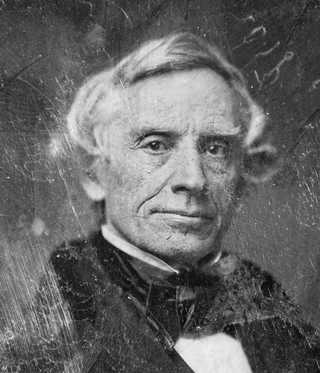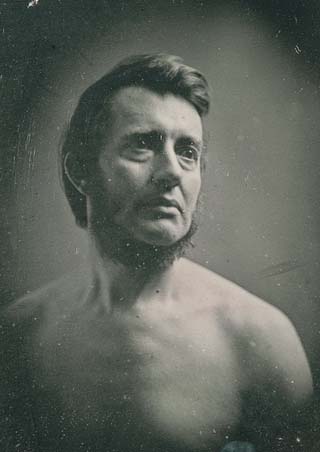Communications Revolution 1815-1860
|
Progress of the Century from Currier & Ives
|
|
daguerreotype of Morse by Brady, ca. 1844, from LC
|
|
half-plate of Albert Southworth, 1848, from Eastman
|
1825 - Louis Daguerre and Joseph-Nicephore Niepce in France began experiments to capture light by a chemical process on a glass plate, becoming partners by 1829.
1826 - Niepce made an 8-hour experimental exposure from his window in Paris, creating a heliograph that is regarded as the world's earliest photograph. However, Niepce died in 1833 before his process was perfected.
1837 - Daguerre began to achieve successful results with his process of coating copper plates with a silver solution, exposing it to light, and fixing the image with mercury vapor.
1839 - The Gazette de France printed the first news of Daguerre's invention on January 6. Samuel F. B. Morse was in Paris promoting his telegraph and met Daguerre in his studio March 2 and 9. Morse published his description of the process in the New York Observer on April 20. Daguerre made the official announcement of his invention to the public on August 19, giving away the process to the world for free. Joseph Saxton of Philadelphia made one of the first American daguerreotypes from the window of the United States Mint on Chestnut Street In September, Morse made his first daguerreotype in New York, an image of the Church of the Messiah and surrounding buildings on Broadway. Morse's friend Professor J. W. Draper of New York University made the first portraits, eyes closed for the 15-minute exposure. In Philadelphia, Joseph Saxton in Philadelphia made a photo of the Pennsylvania Arsenal Oct. 16. Robert Cornelius made a self-portrait in November that was exhibited before the American Philosophical Society December 6.
1841 - William Henry Fox Talbot in Britain patented his paper negative process but kept it secret.
1843 - Albert Southworth and Josiah Hawes began a partnership in Boston lasting to 1862. At an auction in 1999, a whole-plate daguerreotype of clouds in the sky over a Boston rooftop sold for $354,500.
1844 - Mathew Brady opened a daguerreotype studio in New York City on the top floor of Broadway and Fulton, across the street from P. T. Barnum's American Museum. In 1845 he began his Gallery of Illustrious Americans. In 1847 he opened his D. C. studio and made a plate of James K. Polk, the first president to be photographed in office.
1846 - A Texas amateur photographer made the first daguerreotypes of war, in Saltillo of Gen. John Wool.
1849 - Edward Anthony started his photographic supply company, E. and H. T. Anthony & Co.
1850 - Louis Agassiz was hired by southern slaveowners to prove the racial differences between whites and black slaves, using daguerreotypes made in South Carolina by J. T. Zealy.
1851 - Crystal Palace World's Fair in London exhibited daguerreotypes. Frederick Scott Archer in England developed the collodian or wet plate process, that was first used in the U. S. by Edward Anthony.
1854 - James Ambrose Cutting patented the ambrotype process, using a negative on a glass plate backed with a black material to make the image look positive.
1855 - Roger Fenton made 360 glass negatives of the Crimean war Mar. 8 to June 26.
1856 - The tintype is patented and offered as a cheap alternative to expensive daguerreotypes.
1860 - The carte-de-visite was a positive paper print mounted on cardboard 4.25 in. x 2.5 in.
1862 - Alexander Gardner made 95 glass negatives starting Sept. 19 of the aftermath of the battle of Antietam, including dead bodies still lying on the battlefield where they had fallen Sept. 17. He published prints in his 2-volume Sketchbook of 1866 that sold for $150.
1863 - Alexander Gardner with Timothy O'Sullivan made 60 glass negatives starting July 5 of the aftermath of the battle of Gettysburg, including the "Sharpshooter at Devil's Den."
Links:
- Nationalizing Power
- Economic Takeoff
- Printing Technologies from Victorian Web
- America Singing: Nineteenth-Century Song Sheets 1800-1880 and history
- Historic American Sheet Music, 1850-1920 from Duke University
- National Postal Museum
- Illustrated London News
- Penny Magazine Online Home Page
revised 8/22/05 by Steven Schoenherr at the University of San Diego | daguerreotypes | on reserve

